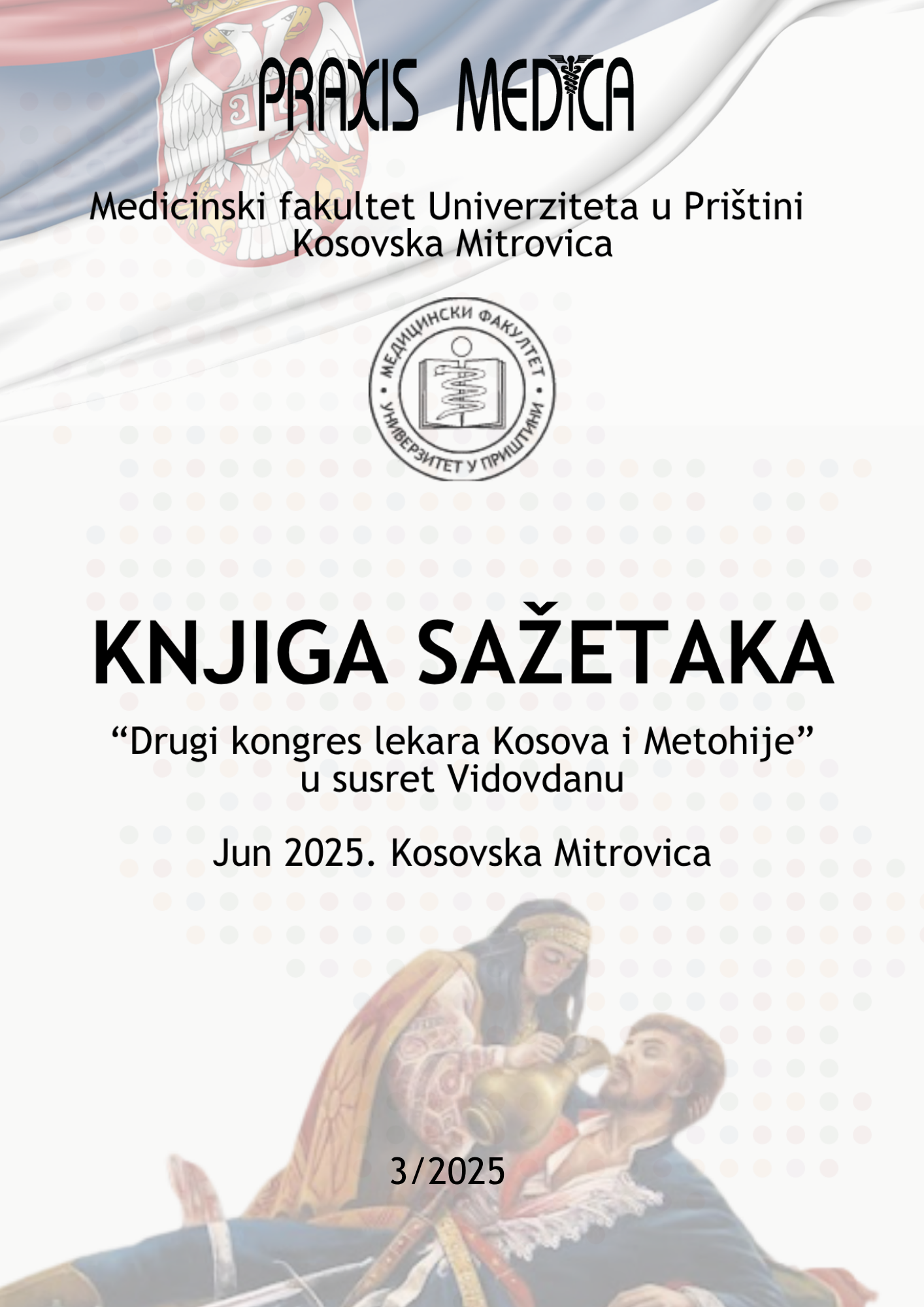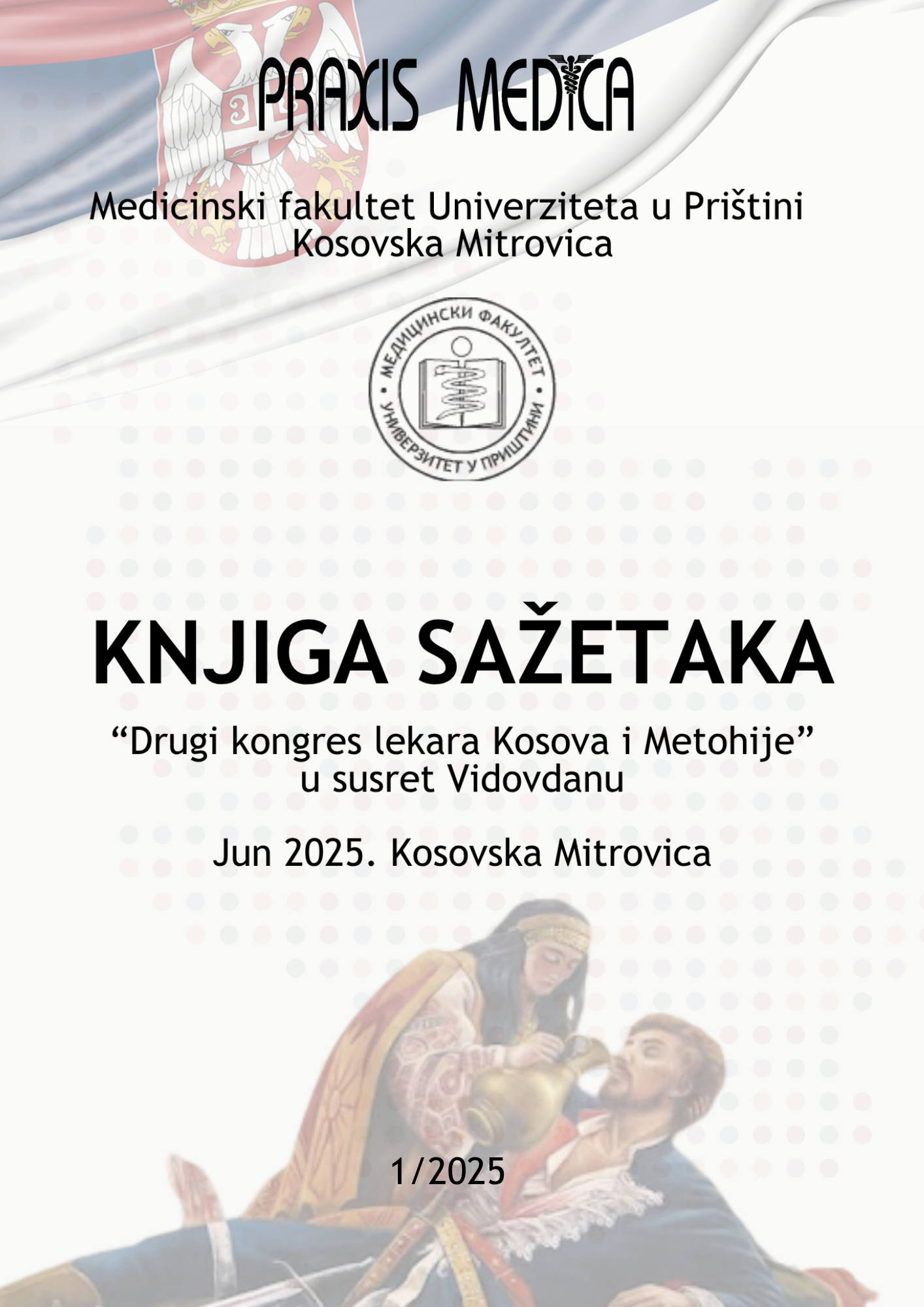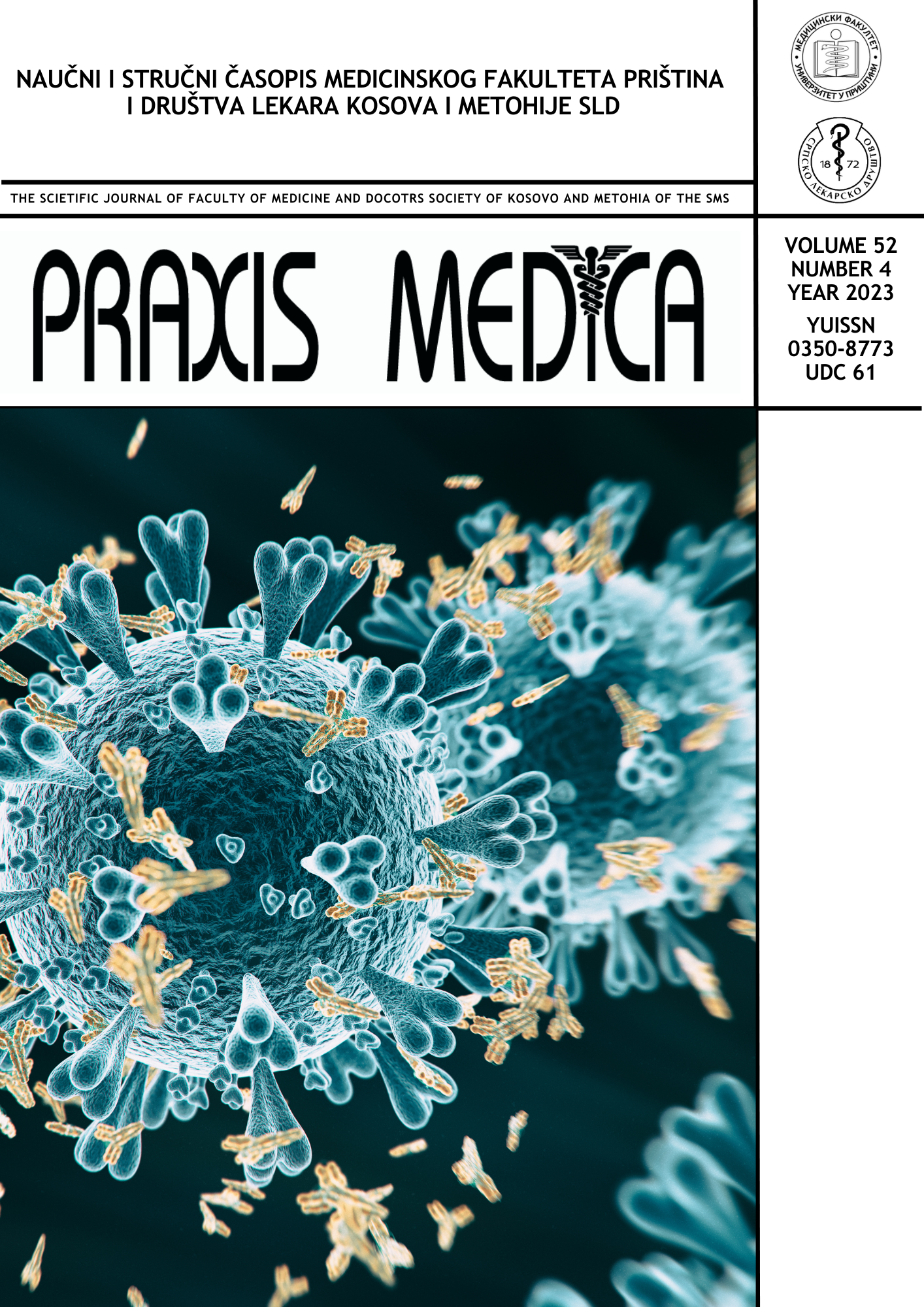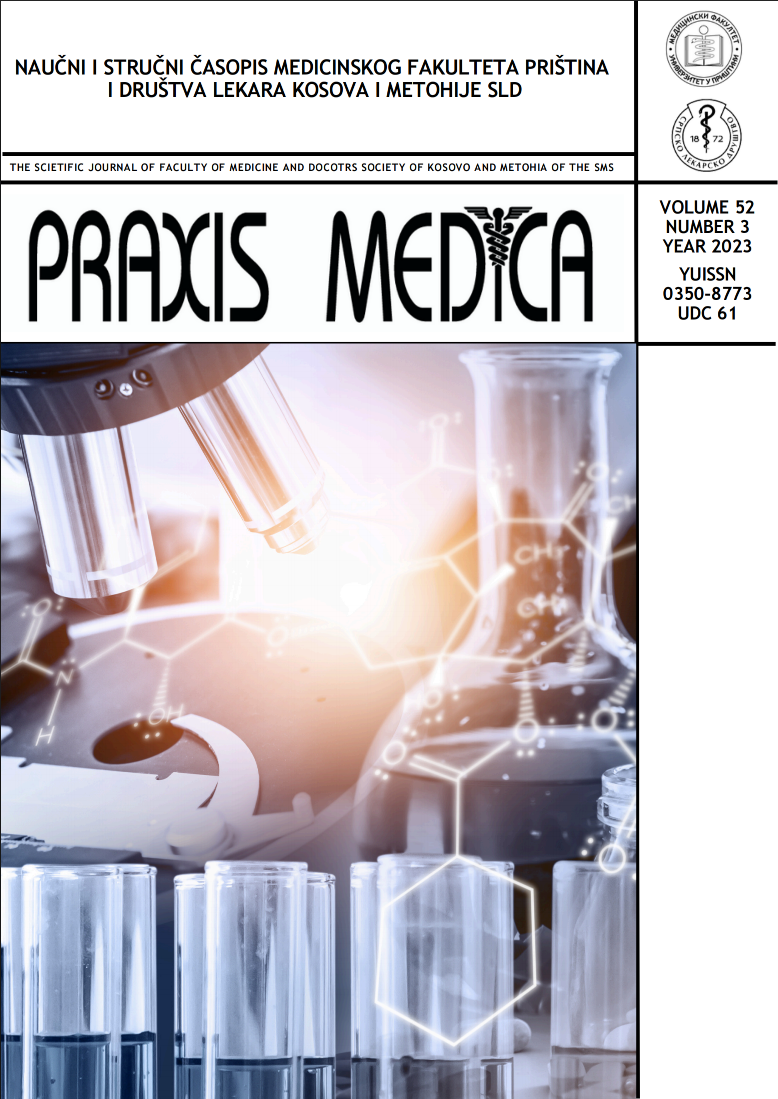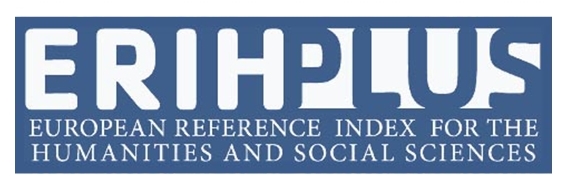Current issue

Volume 53, Issue 4, 2025
Online ISSN: 2560-3310
ISSN: 0350-8773
Volume 53 , Issue 4, (2025)
Published: 30.06.2025.
Open Access
All issues
Contents
01.12.2020.
Professional paper
Prevalence, etiology and treatment of psychogenic aphonia in children: A case report
Introduction. Emotions are one of the most important psychological processes, with a decisive influence on a person's voice. Faced with the great challenges and changes that primary and secondary socialization agents impose in the process of growing up, children consequently experience a spectrum of various unpleasant feelings: anxiety, fear, anger, frustration and sadness. Due to the fast-paced lifestyle, it often happens that the child ignores unpleasant feelings, which further worsens the condition in which he finds himself. Among other conditions, psychogenic aphonia in children has become more frequent in recent years. The current case report aims to determine the frequency of psychogenic aphonia in children, to identify the most common causes that lead to psychogenic aphonia and highlight the methods of vocal treatment that give the best results during rehabilitation. Case report. The current paper presents the results collected in a two-year period at the Clinic for Ear, Throat and Nose of the Clinical Hospital Center "Zvezdara". In the period from March 2017 to May 2019, psychogenic aphonia was diagnosed in 31 patients, which is an evident increase compared to the previous ten-year period in which psychogenic aphonia was diagnosed in 38 younger patients. Analyzing heteroanamnestic data obtained from parents, the most common answer about the cause of psychogenic aphonia is dissatisfaction with school success. After successful diagnostics by an otorhinolaryngologist, psychiatrist and vocal pathologist, in the process of rehabilitation of psychogenic aphonia, methods of digital manipulation of the larynx, methods of restoring the voice with cough reflex and methods of turning out the feedback system were applied. In this particular case, the method of digital manipulation of the larynx gave the best results. Conclusion. Optimal evaluation of patients with voice disorders requires the joint efforts of experts from different disciplines. Having in mind the tendency of recurrence of psychogenic aphonia, these findings suggest that the integration of the interventions of a vocal pathologist and a psychiatrist could give effective results in the process of rehabilitation voice.
Mirjana Petrović-Lazić, Ivana Ilić-Savić
01.12.2020.
Professional paper
Effectiveness of coronavirus disease-19 vaccination on disease transmission, hospitalization, and clinical outcomes in adults in North India
Background: Covaxin and Covishield vaccines have rapidly rolled out in India to curb the pandemic. We aimed to test the hypothesis that COVID-19 vaccination is clinically effective. Methods: This study was conducted in the Department of Physiology at MGM College, Jaipur, India after approval from the Ethics Committee. Vaccinated and non-vaccinated groups were tested on disease transmission, hospitalization, and clinical outcomes. Researchers collected data using questionnaires circulated through google forms. The association between attributes was tested using the chi-squared test. The significance level was considered at 5%. Results: The vaccination significantly reduced disease transmission of COVID-19 [c2=4.51; p = 0.034]. However, no significant differences were seen in RTPCR positivity, chest CT findings, and hospitalization on vaccination. COVID-related symptoms and their severity were not statistically different between the two groups. Most elderly were vaccinated [c2=41.68; p < 0.001]. Most youths took one dose, while the elderly took two doses of the vaccine [c2=41.77; p < 0.001]. All age groups had similar severity of AEFIs [c2=13.22; p < 0.21]. The vaccination status across gender did not differ significantly. [c2=1.13; p < 0.288] Most males took two doses as compared to females [c2=6,57; p < 0.01]. Adverse effects post-immunization were more severe in females than males [c2=13.10; p < 0.001]. There was no association between the number of vaccine doses and the severity of AEFIs [c2=16.42; p = 0.06]. Conclusion: The present study concludes the beneficial effect of vaccination in reducing disease transmission. However, vaccination has no role in mitigating other COVID-related outcomes.
Kshitij Shah
01.12.2019.
Professional paper
Jarisch-Herxheimer reaction during therapy of neuroborreliosis
Introduction. Jarisch-Herxheimer reaction implies trembling, headache, temperature, rash, meningitis, respiratory problems, liver, kidney and heart dysfunction during antibiotic treatment of Lyme disease. Case outline. A 47-year-old patient in May 2016 had circular redness on the thigh, fatigue, myalgia, nausea and headache. Borrelia Burgdorferi IgM antibodies were positive. She took doxycycline 200 mg/day, four weeks. Western blot IgM and IgG were positive as well. Retreated with Azithromycin, 500 mg/day, three weeks. Next year, there was a sleep and memory disorder, fatigue, dizziness, right leg paresthesia and burning in the soles, muscle weakness, decreased sensitivity and right foot hyperreflexia. Electromyography showed axonal degeneration of the peroneus and the tibialis. Pleocytosis (5 leucocytes/mm³) and intrathecal IgG were found. Magnetic resonance of the head in order. Neuroborreliosis was diagnosed and treatment included ceftriaxone, 2 grams/day, three weeks. After the second dose, trembling, myalgia, headache, nausea, flushed nose, dizziness and nausea started. Temperature 37.8°C. No changes on the skin. The antibiotic was not interrupted, symptomatic therapy was administered, and after two days the symptoms stopped. Neurological disorders have not completely disappeared. Titre antibodies still present. Conclusion. Jarisch-Herxheimer reaction occurs in 7.0-30.0% of patients treated for Lyme disease. Causes are multifactorial. Spirochetes release toxins, hypersensitivity is present, phagocytes destroy agents, complements and cytokines are activated. It is often not recognized. Tremor, fever, myalgia and skin rashes are present before the antibiotic, and the worsening is attributed to the underlying disease or allergy. Doctors should expect it during the treatment of spirochete-related diseases and provide appropriate care.
Snežana Knežević, Jelena Vulović, Marijana Jandrić-Kočić
01.12.2019.
Professional paper
Bruxism
Bruxism is a parafunctional activity of the masticatory system, which is characterized by clenching or scraping of teeth. This condition is often accompanied by a change in the shape and size of the teeth, as well as the function of the stomatognathic system. Bruxism can occur during sleep and in the waking state. The etiology is multifactorial and all causes can be divided into peripheral and central. The clinical signs and symptoms of bruxism are primarily characterized by temporomandibular disorders, the appearance of bruxofacets and changes in the hard dental tissues, supporting apparatus of the teeth and masticatory muscles, as well as headaches. The diagnosis of bruxism is made on the basis of anamnesis and clinical signs and symptoms, while electromyography and polysomnographic analysis are used in scientific researches. Therapy is aimed at controlling etiological factors and reducing symptoms. Occlusal splints are the most commonly used in the treatment of bruxism. Medications are used in situations when other methods, including psychotherapy, do not give positive results. Given the multifactorial etiology, the therapeutic approach must be multidisciplinary. The approach to the patient must be individual in order to treat as effectively as possible.
Nadica Đorđević, Jelena Todić, Dragoslav Lazić, Meliha Šehalić, Ankica Mitić, Radivoje Radosavljević, Aleksandar Đorđević, Ljiljana Šubarić
01.12.2019.
Professional paper
The immediate effects of the Covid-19 pandemia on postpartum women
The new pandemic, caused by the corona viral disease 2019 (Covid-19), has brought with it a series of restrictive measures that have drastically altered people's way of life and which restrict freedom of movement, behavior and social engagement. At the time of pandemia, almost all aspects of each individual lifestyle have been impaired, especially in members of vulnerable groups, particularly women in postpartum women. Acute psychological reactions to a pandemia may include insomnia, fear of infection, anxiety, frustration, panic attacks, loneliness, but also depressive episodes. Non-psychotic postpartum mood and anxiety disorders can occur as an inability to adapt to stressful life situations. A comprehensive understanding of the impact of the pandemia on the mental health of women in the postpartum period is needed, in order to devise adequate approaches to recovery from such a major disaster as the Covid-19 pandemic.
Jelena Stojanov, Aleksandar Stojanov, Miodrag Stanković, Olivera Žikić
01.12.2019.
Professional paper
Postpartal depression and thyroid disorders
Introduction: Postpartum depression negatively affects a woman's quality of life and the development of a relationship with her child, which can have far-reaching consequences on the cognitive, behavioral and emotional development of the child. Etiology includes genetic predisposition, sudden hormonal changes, and sociodemographic factors. Case report: A 28-year-old patient, married, mother of a one-month-old boy. She graduated from the High school of economics, unemployed. She appears in the family medicine clinic due to chronic fatigue and bad mood, at the insistence of her husband, who thinks that she needs professional help. She grew up in a harmonious family. He gets along well with his wife, there are no existential problems. It denies previous illnesses. Neat appearance, inconspicuous posture and behavior, psychomotor diskette slowed down, more sparse spontaneous verbalization, slightly compromised volitional instinctual dynamisms, lowered basic mood. In the laboratory findings, hypothyroidism with elevated thyroid peroxidase antibody and antithyreoglobulin antibodies is detected. The thyroid ultrasound verifies the right lobe of 46x14x15mm, the left lobe of 48x13x12mm, inhomogeneous and easily hypoechoic structure. The Edinburgh Postnatal Depression Scale indicates the presence of depression (total score 18). The patient is referred for a consultative examination by a psychiatrist and a nuclear medicine specialist. Psychiatrist indicates the introduction of Sertralin 50 mg tablets (1x1/2 for the first seven days, then 1x1) and Bromasepam tablets 1,5 mg (2x1/2), nuclear specialist Levotiroskin sodium tablets 50 mcg (1x1/2 for 5 days and 1x1 for 2 days). After six months, withdrawal of the symptoms of the disease and exclusion of therapy by a psychiatrist. Conclusion: Autoimmune thyroid disease is a significant and often unrecognized cause of postpartum depression. Early detection and timely therapeutic intervention of these have a significant role in the prevention and successful treatment of postpartum depression.
Marijana Jandrić-Kočić
01.12.2019.
Professional paper
Oral health in patients with chronic kidney disease
Objective: In the available literature data, there is not much information about problems of patients with end stage kidney disease in relation to oral health. Our objective was to show the importance of oral diseases for patients on hemodialysis. Data sources: In this review article, the sources of data are review articles and scientific articles in the English language published in MEDLINE database. The choice of studies was based on keywords: Chronic kidney disease, Hemodialysis, Oral health, Periodontal diseases. Results: It is assumed that almost 90% patients with chronic kidney disease manifest some symptoms of oral disease. Therefore, it is important to determine the impact of periodontal disease on the progression of kidney failure in these individuals, to evaluate inflammatory parameters in this patient population, to assess the degree of bone loss and periodontal disease index, to determine the presence of bacterial strains, paradontopathy of gingival fluid and antibody titers, to examine correlations of proinflammatory cytokines in the gingival sulcus and serum, as well as to determine the relationship between periodontal tissue and inflammatory mediators. Periodontal diseases can increase the possibility of developing chronic kidney disease by 1.5 to 2 times. These oral diseases include gingival hyperplasia, periodontitis, xerostomia, unpleasant breath, changes in the oral mucosa, malignancies, oral infections, dental abnormalities and bone lesions. Conclusion: This requires serious cooperation between nephrologists and dentists to make proper communication possible, in order to provide quality dental care for this growing patient population in accordance with new treatment strategies.
Radojica Stolić, Vekoslav Mitrović, Naja Suljković, Dušica Miljković-Jakšić, Aleksandra Balović, Roksanda Krivčević, Sanja Jovanović
01.12.2019.
Professional paper
Uticaj porođajne mase i aktuelne težine deteta na nastanak prevremenog puberteta
Introduction: Puberty is a juvenile developmental period accompanied by intensive growth and acquisition of reproductive ability. The onset of puberty is influenced by many factors: genetics, neuropeptides and glycoproteins, gonadotropins, sex hormones and the child's nutrition status. Premature puberty is defined as the appearance of secondary sexual characteristics in girls before the age of 8, and in boys before the age of 9. The aim of this paper is to analyze the published results on the importance and influence of factors such as birth weight, current weight and BMI on the development of premature puberty. Results: Eating disorders caused by eating high-calorie foods lead a child to obesity, which is accompanied by premature puberty. On the other hand, conditions characterized by reduced nutrition may be accompanied by delayed puberty. According to the results of this study, children with more pronounced manifestations of precocious puberty had a significantly lower birth weight Discussion: Birth weight of less than 2500g, as well as newborns' SGA (small for gestational age), are directly related to earlier pubertal maturation. Five decades ago, Frich et al. found that reaching a body weight of 48 kg in girls is a "critical mass" for development of menarche. Conclusion: The occurrence of secondary sexual characteristics is more frequent in children with increased body weight and correlates inversely with the child's birthweight.
Snežana Marković-Jovanović, Maja Ješić, Vlada Bojić, Aleksandar Jovanović, Zorica Živković, Andrijana Karanović, Vera Zdravković
01.12.2019.
Professional paper
The frequency of bucal and palatal impaction maxillary canines
Introduction: Maxillary canines are usually impacted teeth the second after third molar. Frequency of impacted maxillary canines is about 1 to 3% of population (in 85% of the cases palataly, and in 15% of the cases bucaly). The aim of this research was to find the frequency of bucal and palatal impacted maxillary canines in relation to sex and position of impacted tooth. Matherial and method: We analyzed three-dimensional computed tomography images (CBCT) of 64 examinees (aged 12 to 33 years) with 80 unerupted maxillary canines to plan the orthodontic therapy. Results: Among 64 examines with impactions, 80 impacted maxillary canines are diagnosed. The average age of all respondents in the survey is 16,3±4,3. Of 64 examinees in research 41(64.1%) were female which is significantly more important than the representation of male examinees whose number was 23(35.9%). Frequency of unilateral impactions of maxillary canines is three times higher 48 (75%) in comparison to bilateral impactions 16 (25%). Of total 80 impacted maxillary canines 19 (23.75%) were bucal impacted, 3 (2.75%) in the middle of alveolus and 58 (72.5%) palatally. With the bucal and palatal impaction usually was represented partially vertical impaction (70%); completely horizontal impaction (10%) was represented only in the palatal impaction. Conclusion: The analysis of CBCT images of maxilla shows a statistically significant frequency of partially vertical, unilateral and paltally localized impacted maxillary canines.
Sanja Simić, Jasna Pavlović, Vladanka Vukićević, Amila Vujačić
01.12.2019.
Professional paper
Relationship between ACR and other determinants of microalbuminuria in T2DM patients
Introduction: The occurrence of microalbuminuria in type 2 diabetes mellitus (T2DM) patients is regarded as an early clinical sign of incipient kidney damage. Microalbuminuria is often evaluated as urinary albumin to urinary creatinine ratio (ACR). Aim: To assess determinants of microalbuminuria in T2DM patients without prior diagnosis of nephropathy using ACR cut-off values. Materials and Methods: ACR was measured in a total of 90 T2DM patients, during two months in three non-consecutive days, and routine biochemical analyses were performed, including glycated hemoglobin (HbA1c), serum uric acid (SUA), and atherogenic index of plasma (AIP). The cut-off values of ACR were ≤ 2.5 mg/mmol in males, and ≤ 3.5 mg/mmol in females. Duration of T2DM, history of hypertension, HbA1c, estimated glomerular filtration rate (eGFR), AIP, and SUA were investigated for association with microalbuminuria. Results: According to ACR patients were considered as non-albuminuric (n= 57) and microalbuminuric (n = 33). Compared to non-albuminuric group, microalbuminuric group had increased urinary creatinine, urinary albumin, HbA1c, triglycerides and SUA, whilst decreased HDL-cholesterol levels. Although eGFR was generally reduced, the correlation between LogACR and eGFR was not significant (p > 0.05). However, the correlation between LogACR and LogHbA1c was significant. The multiple logistic regression analysis revealed HbA1c (t = 3.42; p = 0.012) and SUA (t = 2.44; p = 0.040) as independent predictors of microalbuminuria in T2DM patients. Conclusion: At ACR cut-off values, concentrations of HbA1c and SUA were independent predictors of microalbuminuria in T2DM patients not yet diagnosed with nephropathy.
Dijana Mirić, Bojana Kisić, Dragana Puhalo-Sladoje, Bratislav Mirić, Dragiša Rašić, Ilija Dragojević, Dragana Pavlović


